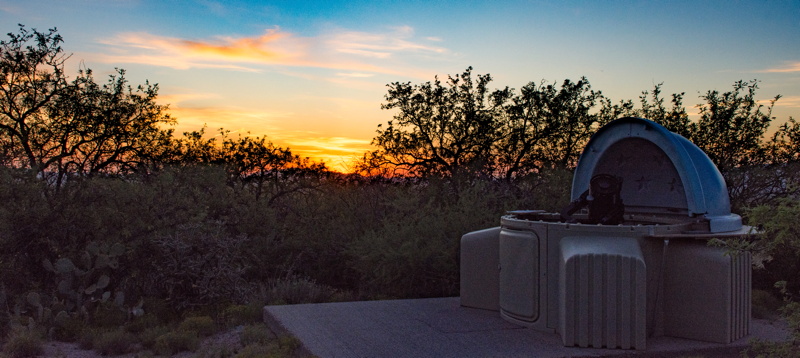D7200 DSLR Imaging: HDR Moon
Posted: 21 April 2016
Clouds began coming in mid-morning Tuesday, 19 April 2016. A mostly overcast sky that night eliminated imaging an excellent pass of the International Space Station. Wednesday, 20 April, dawned mostly clear.
Pier installation is scheduled for Thursday, 21 April. As the concrete epoxy will take 24 hours to fully set, the telescope will not be re-installed in the observatory until Friday, 22 April. Unfortunately, clouds are forecast to return Friday.
|
Open: Wednesday, 20 April 2016, 1811 MST Temperature: 96°F |
Session: 951 Conditions: Mostly clear, clouds west-north |
This would be a short session as there was a lot to do the next day to prepare for the pier installation.
1819 MST: dome to PZT. I checked the two center bumpers and determined that they could be moved outward several inches, which would allow the dome to be moved an additional 2" onto the table. I will make the modification soon.
1830 MST: LX600 ON, StarLock OFF. Used the Wireless AutoStar II, which has been working fine since I repaired it. I did not try to view Mercury as there were too many clouds in the western sky. 1835 MST: viewed Jupiter, 102X. Two moons were visible: Io and Ganymede. Thin clouds had quickly moved over much of the sky, including at Jupiter. The Great Red Spot was visible when the clouds permitted. 1854 MST: four moons now visible.
1857 MST: waxing gibbous Moon rose over the hill to the east. 1859 MST: sunset:

Switched to the William Optics Binoviewers and viewed Jupiter at 195X. Nice view at times. Ganymede's disk was occasionally visible.
1921 MST: began preparing the D7200 DSLR for prime focus lunar imaging.
1927 MST: removed the 1.6X Barlow Lens from the Binoviewers at viewed Jupiter, 122X. The Great Red Spot was at the Jovian limb.
GOTO the Moon. Removed the star diagonal and viewed the Moon through the Binoviewers at 122X using the visual back. A slight terminator was visible.
Mounted the DSLR at prime focus + visual back + focal reducer. Did some bracketed exposures of the Moon for HDR processing in Adobe Lightroom. This image was created using exposures at 1/400sec, 1/800sec, and 1/1600sec, at ISO 400, White Balance Auto:

Click or tap on image for larger version
1949 MST: ended imaging.
1952 MST: last look at the Moon this night, 102X.
This was the last use of the LX600 tripod in the observatory (hopefully, if all goes well with the pier installation).
|
Close: Wednesday, 20 April 2016, 2010 MST Temperature: 70°F |
Session Length: 1h 59m Conditions: Partly cloudy |
Comments are welcome using Email. Twitter users can use the button below to tweet this report to your followers. Thanks.
Cassiopeia Observatory Home Page
Copyright ©2016 Michael L. Weasner / mweasner@me.com
URL = http://www.weasner.com/co/Reports/2016/04/21/index.html
